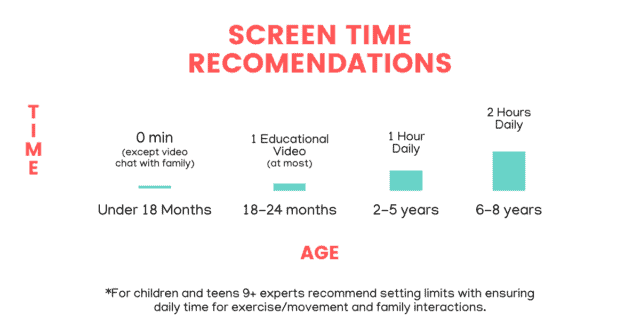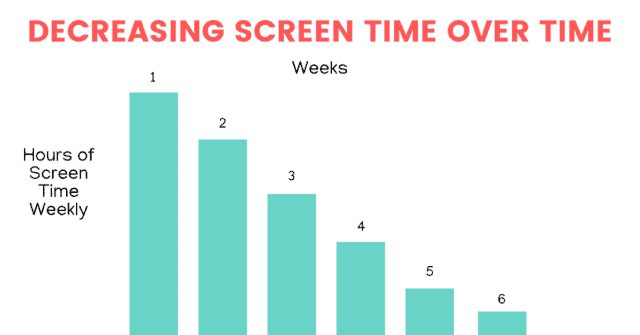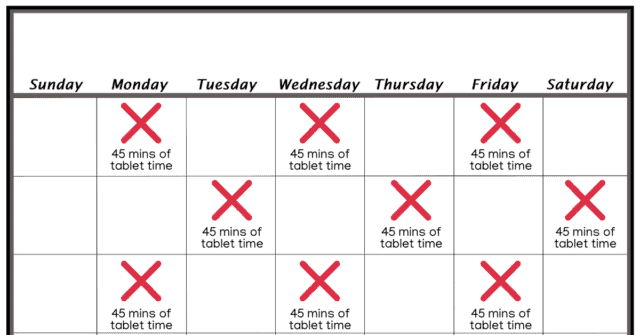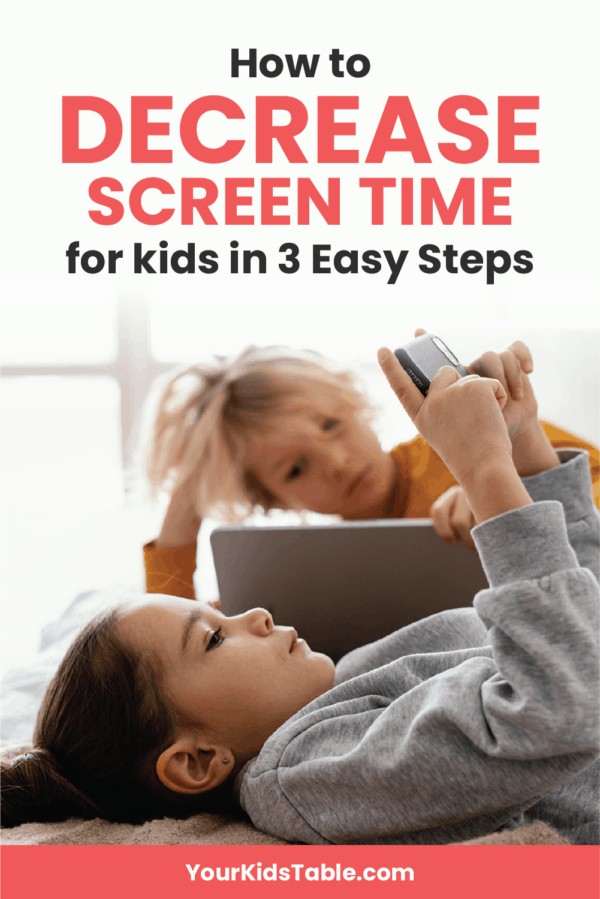How much is too much screen time for kids? And, how the heck do you actually get them to cut back on that much loved screen time? Find out how by using 3 simple steps you can literally do today!
Smart phones, tablets, TV’s, and computers surround most of our lives.
And, our kids’ lives.
Having your kid watch a screen or play with an app while you get dinner ready or take that important phone call can be a lifesaver, but even from a very young age, kids seem to want more and more screen time.
While screens have their benefits and can be used in positive ways, many parents wonder how much screen time is too much. And, how can you decrease the amount of screen time your kid has if they freak out when you try to take it away?
As a mom, I’m constantly asking myself these questions. I look at recent research, and follow experts as they observe trends in the development of our technological-era kids.
And, as an occupational therapist, in the last decade, I’ve personally seen sensory needs, anxiety, and even picky eating difficulties heightened because of too much screen time for kids.
What’s the Harm in Too Much Screen Time for Kids?
What’s the big deal about screen time?
Well, as an OT, hands down my biggest concern with screen time is that when a child is sitting and watching a screen, or playing a game on a screen, they aren’t moving, exploring, and often aren’t fully stimulating their imagination, sensory system, or development.
Yes, there are some amazing learning apps and games. In moderation, they can be tremendously helpful for some kids.
But, the average game or YouTube video kids watch is a very passive experience. It’s entertainment.
Again, this isn’t a bad thing when kids enjoy those types of screens in small doses, but many kids watch a show or play a game and they want more.
And more.
And more.
Screen time can quickly turn into your child’s go-to activity. Which means they aren’t doing the many other things that they could be doing instead of staring at a screen like playing outside, building Legos, drawing, or writing their own creative story out on paper.

Screen time is often not active learning
But, active play, reading, building, and exploring are the things that increases their IQ, fine motor skills, visual perceptual skills, gross motor skills, and a lot more.
Age appropriate play activities feed kids a variety of sensations that stimulate their brains sensory processing. This too is critical for all learning and development. A child’s sensory system receives a passive stream of visual and auditory stimulation while they sit and stare at a screen, which can cause sensory needs to occur or worsen because they aren’t getting the right type of sensory input they need.
I see this play out all the time in my own home.
If my kids have a lot of screen time in one sitting, when I finally pull the plug, they are literally bouncing off the walls. They’re hyper and have difficulty listening to me. 2 of my kids don’t usually display sensory needs, but they do after extended screen time.
The colors and lights have been giving a steady dose of stimulation that increases their activity
While the screen is on, they’re locked in to watching, but once it goes off, all that extra stimulation spills over. Some kids jump off the couch and run wild. Other kids may seem anxious and irritable. And, still other kids will have a tantrum or meltdown.
I’ve witnessed this in my own home dozens of times, and I hear similar examples from my students in our sensory and picky eating programs.
Screen time can even affect picky eaters…
…because that spill over of stimulation or sensory dysregulation, can affect a child’s appetite. After having screen time, they may feel out of balance and can’t think about eating. Or, if the only way a child will eat is by watching a screen, then they’re passively eating.
Sometimes parents have to rely on tablets and TV shows when their child has a lot of feeding difficulties, but it’s also a crutch that makes it difficult for them to learn to eat new foods. Learn more in Why Screen Time and Eating are a Bad Idea.
Could your kid be addicted to screen time with a tablet, video game, or phone?
Electronic addiction is a real thing, while it only affects 2-3% of all children, many other children are close to what psychologist Jay Berk calls the danger zone. The danger zone is when a child could become addicted because of their strong preference for screen times.
However, what’s more likely, especially as children become preteens and teens, is that they replace screen time with social interactions, which could be due to underlying social difficulties and other developmental challenges. Read more about excessive electronic use here.
What is Too Much Screen Time for Kids?
Our kids live in the digital age. Most kids are surrounded by screens, even in the educational system. In this past year, we’ve seen the tremendous resource this was as the world shut down and many children could still learn remotely – through a screen.
For most parents, totally eliminating screens isn’t an option and I don’t know that it needs to be.
Although, I think it’s quite telling that many of the top silicon valley tech and media gurus send their children to private schools that USE NO SCREENS at all. Tim Kendall, former facebook director of monetization and Pinterest president, stated in The Social Dilemma, a Netflix documentary (I highly recommend watching no matter what age your child is) that as a parent, he’s almost a zealot about not letting his kids have any screen at all.
My kids are in a school that uses technology a lot, and they’re surrounded by peers and neighbors that use screens often. While a part of me would totally love to eliminate screens, I think at my kid’s age, it was cause more harm than good for them socially.
My goal is to teach them to use screens responsibly and show them the value, importance, and benefit of time away from screens.
As a parent, you’ll need to decide what your comfort level is, but in the chart below, you’ll find a list of best recommendations by age from the American Academy of Pediatrics, American Academy of Child and Adolescent Psychiatry, and the American Psychological Association.

3 Easy Steps to Decrease Screen Time
The chart above is just guideline. Obviously, as a parent, you get to decide how much screen time you’re comfortable with your child having. Most parents I talk to would love to have their kids using screens less, but they don’t know where to begin.
Maybe your child has had free reign of screens and they use them lot. Or, maybe you’ve tried to decrease screens before and it only results in tantrums, arguments, and meltdowns.
I hear you, but you can follow 3 simple steps to help your child quickly decrease their screen time:
#1: Decide how much screen time you want your child to watch every week or every day.
Do you feel that pang of guilt when you walk by your child for the third time and they’re still on their tablet? You look at the time and realize it’s been at least 2 hours that they’ve been mindlessly starting at the screen, so you say something like, “Why don’t you go play outside? Or, take a break from the screen?”
Depending on the child, they may follow that suggestion, and hop off. No big deal.
Lots of kids will barely respond though because they’re locked into the screen and want to keep watching or playing. They’ll say they’re in the middle of watching something or playing a game, and will get off soon. But, “soon” comes and goes.
You walk past again an hour later and they’re still sitting there on the screen.
If you’re like me, at this point, you’re frustrated out of concern for their inability to step away from the screen. You might get angry, take it away, yell. Or, you may ask them again, but not enforce shutting the screen off.
When you find yourself in this situation, and your child isn’t able to moderate (many aren’t) their screen time, then it’s important to take a step back and decide how much screen time you’re comfortable with your child having.
Use the chart in the previous section as a starting point.
With social distancing over the cold winter months here in Pittsburgh, our kids screen time was getting out of control. I could feel it and see it in their behavior. I decided that I only wanted them to have their tablets or
Nintendo Switch 5x a week for 45 min max each day, and the tablet could only be 3 of those times.
Personally, I’d rather they play a video game that requires some visual perceptual skills instead of staring at another YouTube kids video passively, which is what they tend to do on their tablet.
For reference my kids are ages 11, 9, and 6.
I knew that they’d have more screen time with some television shows and movies we may watch together as a family as well. This is where my comfort level is. I’ll also say that with the weather warming up, I’ll decrease this time further, especially over the summer, if I need to.
I’m just sharing my screen time guidelines as an example. Your limits don’t have to be the same as mine, it could be more or less.
If your child has a lot of screen time every week and your number is drastically lower than they’re used to, you may want to consider slowly decreasing the amount of screen time over several weeks, like in the graph below:

#2: Talk to your kid about the screen time limits – when they aren’t having screen time.
Once you’ve decided how much screen time you’re comfortable with, it’s important to talk to your kids about it. When they aren’t using their screens or you aren’t taking them away.
Dinner around the table is a great time, or when you’re driving in the car. Basically anytime you have their full attention. This is not a conversation you want to have when you’re trying to get ready for school in the morning or when your kid is tired and barely listening.
You’ll want to make your guidelines clear, and give them some control over when they use their time. For instance, you may decide to give them 1 hour of screen time everyday, but they can choose when they have that hour. Or, your guideline might include, screen time only after school, but all screens done by 8 pm.
*All experts agree on having a cut off time of screen time, at least an hour before bed.*
It may help your child to create a calendar or post the guidelines where they can see them. The calendar below is an example of having screen time for 45 minutes every other day:

#3: Enforce the screen time limits.
The third step is simply following through on the guidelines you created. This may be the hardest part. If you’ve had a long day of working from home with your child’s online learning happening simultaneously, then you might fold when they beg for one more show.
I get it, and this doesn’t have to be followed 100% of the time, but your child will test these boundaries to see if you mean them.
Following through on what you set up will show them that you are in fact serious. And, as a result, you’ll see the benefits of decreased screen time. One of our RISE with Sensory students recently shared that her son went to the grocery store and helped her prepare a meal.
Seems like a small thing, but he wouldn’t typically have participated in those activities, which were awesome for his sensory needs, picky eating, and connection to his mom.
Remember, if your child is majorly resisting the decrease in screen time, you can use a gradual approach, adding new limits every week or two.
How to Entertain Your Kid Without Screen Time
Now that your child doesn’t have access to screens as much, they might tell you that they’re bored or whine because they don’t know what to do. This is frustrating, BUT it’s a sign that too much screen time may have affected their ability to play independently.
It’s actually good for kids to get bored, and to problem solve through it. Or, just experience it.
However, learning to initiate and continue play on their own may be a skill they need help with. If so, then think about setting up toys they’ve shown interest in before.
It can take 2 minutes to grab their Lego and push a couple pieces together and say, “Hey, I started building a building, I’m challenging you to turn it into something else. You can use any of the Lego pieces you want.” (Notice I didn’t ask a question. I just set up a challenge.)
A lot of times, you won’t need to say anything, seeing a toy pulled out they haven’t played with in a while and set up will hook them in!
Also, if your child was using a screen a lot they may have never wanted to color a picture or play a game with you, but now that a screen isn’t distracting them you could seize the opportunity to spend 20 minutes of quality of time together.
Get more ideas in How to Keep Kids Entertained Without a Screen or Spending a Lot of Money
How to Mange the Amount of Screen Time for Kids and Teens that Have Their Own Phones
If your child is old enough to have a phone, experts consistently recommend that their phone should go to sleep for the night at any early time. Have your child plug their phone in a neutral location in the home, or even in your bedroom so they can’t use it after a certain time at night. 8 or 9 pm is usually a good rule of thumb to follow.
Kids that are on their phones late are often sleep deprived, or can’t fall asleep because of the stimulating blue lights they were just staring at. This also tends to be the time that kids may look at, receive, or send inappropriate images or texts.
How do you feel about screens in your home? Leave a comment below…
If you couldn’t tell, I’m really passionate about too much screen time for kids. It’s a tricky topic, because we’re the first generation of parents that have had to navigate screens on this level. We’re learning. It would be so helpful to hear how you feel about screens in your home. Or, any clever strategies you’ve used to help your child decrease their screen time.
Remember, that we all have different perspectives, so please only share supportive comments. We aren’t about judging or blaming around here. But, we are about sharing and learning together.
Leave a comment below, and take a minute to share this article with other parents that are trying to navigate screen time. You’ll find sharing buttons below!
More on Kid’s Development
Incredible Child Development Toys to Help Your Child Thrive
Visual Perceptual Activities: 4 Ways to Boost Your Kid’s Development
7 Unseen Struggles Kids Have in the Classroom That Make Them Look Like a Bad Student
Alisha Grogan is a licensed occupational therapist and founder of Your Kid’s Table. She has over 17 years experience with expertise in sensory processing and feeding development in babies, toddlers, and children. Alisha also has 3 boys of her own at home. Learn more about her here.

I HATE EXERCISE!!!!!!!!!!!
I hate exercise
thanks for a great article! made me rethink screen time.
Hi Elzeth,
Thanks for getting in touch! We are so glad it was helpful!
Best,
Andrea
Hi my mother took care of my son while I worked for the first year of his life. I made a rule of no screen but my mother decided to do it anyway. Now my son is 16 months old and cannot eat without an iPad in front of his face. We do not do any meals on the table as my husband and I – either one of us are not home at the same time. My son said “change” everytime a song turns on because he’s so bored of it and I am changing the channels more than I am feeding him. He’s become lazy and when that screen turns on he wants me to feed him instead of looking down at his food and eating himself. I really need help and dime guidance!! Thank you!!
Hi Saba,
Thanks for reaching out! This is a really common problem. You might try slowly reducing the time the screen is on during meals. One of the best ways to do this is to set up your son for his meal with the food in front of him and “forget” to bring the ipad to the table. You can act distracted or say “I’ll grab it in a minute” before you bring it to the table. Over time you’ll be able to reduce and then eliminate screens during meals. We also have a post about teaching your toddler to feed himself. It might be helpful for you! Feel free to reach out if you have any questions!
Best,
Andrea
I had the same issue and she was picky ester. She was 19 months and was barely moving her jaws (initially screen worked good to finally start eating solid food) and i lost my patience and just told her no more screens! You eat if you want but mommy is going to eat! She adjusted very well and fast, and hadn’t asked screen time even outside of meal time because she cannot distinguish, what she understood that mommy is not letting her watch cartoons anymore! She is 2 now. But recently started to give her vitamins (ped recommended) and she finally has appetite and eat more variety of food by herself! Other reviews mentioned about increased appetite but it was difficult to believe, the magic happened on 3d day!
Hey Julia,
Thanks for sharing your experience! Getting rid of screens can be such a challenge, but worth it!
Best,
Andrea
Myopia in kids, and weak posture/back pain, is going to be really commonplace now.
In the UK, in addition to educational games, many schools have videos on a lot, while groups of kids do other things. It leads to already loud classrooms being even louder and more chaotic. Not great for sensory needs. Our kids often say school is too loud.
Even for focused videos, small kids are required to sit on carpets and look up at a (thankfully big) screen. No one is teaching them to sit in a way that supports their shoulders and backs. (It doesn’t help that most kids chairs, strollers, etc, have backs that lean back). Or that many playgrounds don’t have climbing or hanging apparatus to strengthen shoulders and backs, and offer sensory input. So our kids sadly now have really weak posture (back curled up, head sticking forward) like all their friends in our societies. We try to encourage them to sit like “happy dog”, not “sad dog” (where a different g would sit on its tail). And to climb where they can. Do you have a blog post about posture and eye strain? Strategies welcome.
Hi Kayla,
Increased screen time and not enough physical movement seems to be a problem in so many schools! Many of the more active sensory activities often will address postural needs as well. This can include activities such as scooter boarding on your child’s belly or bouncing on a yoga ball in a seated position. Both of those activities will target the back and postural muscles. We also have an article that addresses visual perceptual activities. These activities will also strengthen the eye muscles.
Best,
Andrea
Great post, Alisha! I love the tips for parents.
This has also been a huge concern of mine! Especially during virtual learning this past year! I really worry about the back and neck position and the eye strain as well, Kayla.
I have a blog post that I created for my site that addresses posture and eye strain during computer use. It gives tips on positioning, preventing eye strain, stretches, etc
https://developlearngrow.com/how-to-prevent-neck-back-and-eye-strain-during-virtual-learning/
Hope it helps!
Thank you. It is so good to hear from someone else who is passionate about the impact of screen time on children – and see some nice strategies. My 7 year old can take or leave screens, but my 9 year old, who has both sensory processing issues and raised levels of anxiety is a classic example of the ‘danger zone’ children you described. Always obsessing about screens & wanting more – and of course he is the one who is bouncing off the walls after screen time. Because of it’s impact on him (and also because of my preference for children to have ‘free play’) we have always had firm, clear, boundaries about screen time with strict limits. It doesn’t mean it is not an ongoing battle or a negotiation. I would love to see or hear more strategies about managing screen time as the children age. Please do keep us up to date with how you go with yours.
Separately I have seen the impact of lockdown screen time on many kids. Do you know if anyone out there is researching the long term impact of lockdown screen time on children?
Hi Claire,
I’m so glad you found us! It sounds like you are on the right track with screen time. You seem to know your children’s limits. It can be frustrating when your child is often pushing boundaries with screen time. We do have another post about how to keep kids entertained without screens. You might find some activities for your kids there! Keep us updated if you hear of any research about the lockdown and screen time. That sounds like a really interesting topic!
Best,
Andrea
I enjoyed the article, but the problem with screen time is an issue for me at my son’s school. They give all kindergartners a chrome book where the kids bring it home and back to school everyday. Some teachers only assign homework in the computer and they make the kids spend 40 minutes a day in class using an educational program while they are chatting. I think the school system is helping kids become addicted to screen time by adding it to the curriculum. Why not make the kids go outside and play or use board games to fill in the computer time? There are distance learning classes lasting 6 hours a day. How come the American pediatrics association is not saying anything about it?
That’s a good question. I do think we’ll be looking back at some point and trying to return to some moderation with screens in school. It’s the same in my kids school and I too get frustrated. A friend of mine wrote a note to the teacher because they were taking a break from screens and told the teacher they’d have to send home a paper copy of the work, and they did. Not sure that will always fly, but wanted to share.
Thanks for these tips! I’ve seen a lot of discussion this year about screen time. We all have felt it was the only way to get through quarantine! I try to be intentional about screen time, it’s so hard but I think it’s really important, I can see a difference in my kids when they have extra screen time. Parents shouldn’t feel bad about needing to rely on electronics sometimes, but we definitely need to decide on limits and stick to them as much as possible.
100%, there are always exceptions! I think that’s such a good way to look at it Erica:)
I’ve found that for kids who are used to having a lot of screen time, decreasing their time can lead them to focus too much time, energy and anxiety on getting more screen time. It’s often more helpful to take a complete break from screens for 2-3 weeks. This gives them time to get past “I’m bored” and start developing other interests, especially if the parent is intentional about providing opportunities for connection like the article suggests. Then, gradually add some screen time back in.
Parents working from home during the pandemic at this moment in time are really struggling with this screen time thing. I have a toddler and I really try hard to limit to next to nothing all day everyday. Instead I might put on a playlist of some of our fav songs on youtube, flip the screen so we can’t see it and have a dance party for 10-20 min for breaks or stop/freeze game. But if I need to take a call for work and she won’t sit still with a toy on her own, I hand her the screen to watch a preschool ed program until I can get back. At this young age, independent play is nearly non-existent.
I totally agree! Screens really can be a good tool, I think intentionality is key. Appreciate your thoughts Benny and Laurie!